


© 2014-2021 Copyright by P. K. H. Groth, Denver, Colorado, USA All rights reserved - See contact page for for permission to republish article
excerpts.
Hunter Neck, Spine,
Bone and Foot Risks
Hunter Back Injuries: You do not see many hunting articles about simple back and leg hazards.
Hauling large packs in and meat loads out takes its toll. Do it right or pay the consequences later in life.
I made it, but the toll was the loss of three inches in height and the absence of most functional
vertebral discs. I have no intent lecturing about lifting weights and backpacking heavy loads. Do let me
tell you that during wet, icy, and snowy weather you have to adjust to conditions. Pushing your weight-
carrying limits on a mucky trail may result in breaking a leg or wrenching your back. Five miles from a
road head is a walking eternity if your back or neck is dislocated. Slowly driving a potholed road to
medical help is going to be the final painful blow.
I have driven back-injured men and heard them whimper at the road ruts. I recall the year I took Josh
elk hunting with me. Josh had driven nonstop nearly 1,500 miles. He was tired when he got to my
house (late and exhausted), and the four hour ride to elk base camp did not adequately replenish
sleep. We were setting up a temporary base camp when Josh somehow dislocated his back. After three
hours, he relented and let me drive him back to Denver for medical treatment. The forty-mile drive to
the interstate drew tears to Josh’s eyes, especially when my Suburban bumper sideswiped a large
boulder hidden in the deep snow. He got chiropractic and medical treatment, and a day of rest. We
were two days late for opening day, but like all enthusiastic elk hunters, he fought for and got a nice
bull. {Interest note: I had a sedentary job that resulted in chronic back problems. My back ALWAYS
recovered before hunting seasons because I exercised more.}
I now carry a week’s supply of back muscle relaxant medicine and prescription pain medicine when
backpacking or hunting. At every yearly physical, I give the doctor the remaining medicine for disposal
(commonly all is left) in return for prescriptions for fresh medicines. I started this relationship when I
picked up a fish in a remote lake I built along the Continental Divide. Linda wire-sawed avalanched
trees with bent bases to fit my hips top contours. Then she strapped me tightly into this back brace
and we walked the seven miles up to the Continental Divide and out to I-70, where highway crew
members helped lift me into our Blazer.
Protect Your Knees: Many backpacking and hunting articles reviewing potential physical and
environmental danger fail to point out a quite likely obvious hazard – a knee injury. A simple stumble
while boulder bashing a trail can bring a painful and potentially life-long knee condition. Of all the
places on your body not to fall, the knee is the worst and most often unforeseen accident. A moderate
strike below the kneecap might initially only slightly hurt, but the bruise may progress to ligament
damage and water boils under the kneecap. I remember slightly tapping my knee. It swelled to double
size by the next day, and then my entire leg turned black and blue. Be tender to your precious knees.
Walk slower to maintain good balance. Off-load some things and make a second trip when hauling
heavy loads (think game meat) downhill. Getting in the in the predicament of being forced down on
your knees can be devastating to the hunt.
Treasure and Protect Your Joints Treasure and respect your vertebrae! Do not overload or over tax
them. Lift properly to preserve them. Never lift with a twist, as when jerking a heavy, clumsy backpack
up to your shoulders. Outdoor activities demand you stay comfortably ambulatory well into old age.
How do hummingbird wings do that! Birdwatchers recently began banding humming birds in Florida.
Banding the tiny birds had never been done before because they are difficult to catch (and later
recatch) without injuring them. Their miniscule legs allowed only thin, fragile bands with little
information. Beside, few people cared where they went, supposing that they “went to the mountains
for the summer” before returning the following fall. Not so! The rascals banded in Tallahassee, Florida
were caught summering in Anchorage, Alaska! Those puny little birds flew over 3,500 miles over the
Rocky Mountain for their summer vacation, and then flew back! Plus, they fluttered about at winter
and summer feeding locations. That is one heck of a feat running on flower nectar!
Let’s look at how much hummingbird wings are used. They flutter at 50-70 times a second 60 flutters X
60secopnds X60mionutes X24hours X365days = 1,892,160,000 wing beats a year. How do they do that!
I am dead serious: some graduate student should study the hummingbird wing joints to develop a
legitimate human joint supplement. That should bring her/him billions. It might also result in a life-
extending elixir – who knows, what helps joints might help the heart! (Note: the black billed warbler
songbird is only slightly larger than a hummingbird. It migrates over the Pacific Ocean from New
Zealand to Alaska and to Japan and back. Do not underestimate nature. Learn from it.
Pay for a Good, Perfectly Fitted Boots – Or Suffer Later: Invest in a good pair of boots for comfort
and foot preservation. Make sure they are correctly fitted. They should have strong, thick Vibram soles,
and have strong built-in arch support to prevent foot failure and permanent flat feet. A poor or absent
arch support will also shift more body weight to the heel bottom, resulting in gradual growth of an
exceedingly painful basal bone spur that may take years to get rid of. Boots should extend over and be
supportive of the ankle to reduce sprains
Custom Boots Fitted by Experts are Worth the Cost: People buy boots today by mail order or from a
local sports store which has inexperienced salespersons. Most will never experience the wonders of
perfectly fitted boots, and some will suffer future foot and ankle problems.
We relocated to Denver in 1969. New backpacking friends vehemently declared we should get the best
boots plus free advice from Hans the German, an eighty year old (and still playing soccer) legendary
boot maker on East Colfax Avenue. He was an extremely rare find from the “old school”. If you were
coming to him, you were going to receive boots that were appropriate to HIS liking. The first thing he
did was to yell at his wife to prepare another customer (he was always politely but loudly yelling
commands to his wife.) Linda was properly seated in a fitting chair barefooted with her old boots
neatly beside her. Hans intermittently eyed her as he went about business with other customers. Hans
carefully looked at Linda’s feet and then her old boots. “How bad is the pain in the left side of your
neck?” he asked (actually, a tort German command). Linda had this neck pain for years and Hans
instantly detected it. He knew the adage “Look at a man’s shoes and you know how he lives”.
Linda got a perfect pair of boots for her narrow feet. Hans made and glued a wedge-shaped leather
“cookie” at a certain place inside her boot. In a week or two, her neck pain disappeared and never
returned!
Hans refused to sell me the impressive stylish hiking boots I selected, demanding I buy a more farmer-
looking rugged type for my “German-Italian fat feet!”. I used those relaxing boots that felt like slippers
through five resolings. (Note: Peter Limmer and Sons in New Hampshire make custom boots for hard
to fit feet. It may take up to three years for the boots to be made. However, they will order contract-
made specialty-to-fit boots made in the former East Germany with arrival time in weeks.) .
Buy Quality Boot Laces for Comfort and Safety - Good Boot Laces Are Almost Worth Their
Weight in Gold!The backcountry is not the place to wear poor grade bootlaces.There are many cheap
ones on the market that stretch, break of loose their end caps. They fray, absorb water and freeze, and
creep through boot eyelets. Obtain some Obenauf’s Industrial Strength Boot Laces. These quality laces
are impregnated with a beeswax/resin/oil mixture. This reduces abrasion, fraying, mildew, heat and
chemical damage and water saturation. Water proofed laces do not ice up and become difficult to
untie. The waterproofing composition also reduces or eliminates the creeping of laces through eyelets,
and thus keeps your laces tight around the foot.
Properly Tie Your Boot Laces for Maximum Comfort and Foot
Safety: Boot maker Hans had a big granite rock in his boot
store’s tiny fitting room. You climbed on and around that rock to
his commands as he observed the boots flexing and the ankles
moving. Then he would teach like a child you learn how to
correctly lace a boot for backpacking. This photo illustrates the
proper way to tie a boot so the foot and ankle are not injured or
fatigued, or a good boot ruined. The lace is pulled increasingly
tighter each eyelet at a time until the break in the ankle is
reached. Then the laces are wrapped around each other several
times BELOW the lowest point of boot flexure (arrows). This intertwining prevents the foot’s flexing
action from pulling and stretching the upper lacers downward to loosen the lower laces. The boot front
retains firm lacing, thus preventing the foot from moving forward, and foot tarsal bones from
spreading. You will experience less foot fatigue, toes hitting the boot front, and better walking balance.
The foot will not slip forward in the boot when walking downhill; this is a dangerous time when
carrying a heavy load of meat. The boot will be able to bend better at the ankle break point, and this
will prevent blistering of the tender ankle front. Note: Never use lacers which stretch at all. They allow
foot slippage resulting in blisters.
Pre-Season Back Exercise to Increase Your High Altitude Breathing: You have two diaphragms
melded as one. There are two phrenic nerves coursing down from your neck vertebrae to control these
two diaphragm sections, which usually act in unison. Three quarters of your air inspiration results from
your diaphragm pulling down from your neck vertebrae to control these two diaphragm sections,
which usually act in unison. Three quarters of your air inspiration results from your diaphragm pulling
down toward the body cavity. The diaphragm will have to work harder if it has to push down against an
enlarged abdomen (think big gut). Try to get rid of that gut. Think of hunting all year, not beer.
About one-quarter of inspiration occurs through the muscular action of your rib cage. Intercostal
muscles contract to make the lung cavity smaller by pulling the ribs together and inward, thus more
completely expelling carbon dioxide enriched air. If you are not physically adjusted to rarified air, you
may experience rib muscle fatigue and pain until the intercostal muscles become toned. Consider
beginning to tone the intercostal muscles and your back muscles with deep breathing well before the
season. You will be able to sleep better if your chest rib muscles are not tender and do not ache at
night.
Breathing Exercises for your Health and Awareness: Doctors advise breathing and breath control is
the easiest way to improve your physical and mental health. Train yourself to breathe deeply and
slowly to boost your immune systems and heart health. Begin breath training well before the hunting
season and you will adjust to high altitudes easier and quicker.
Many of us are tied to the computer during the workday and at home. Your computer work may
indirectly create stress, headaches and fatigue – but not just in the ways you might suspect. “Fitbit”
exercise tracking devises monitor your physical activity. “Spire” is a wearable device that monitors your
breathing rhythm, types, and efficiencies. It was used to expose a new kind of apnea, which is a
temporary cessation of daytime breathing. People in a computer work study often held their breath,
and they commonly took short, shallow breaths that were insufficient to optimally exchange carbon
dioxide for oxygen. This results in fatigue, sleepiness and physiological stresses on body organs like the
heart.
There are two types of breathing. Most people breathe “vertically” using mainly their chest, shoulders
and neck. When exhausted or excited they use the diaphragm more. A better method of breathing is to
use your diaphragm to do most of the inhaling and expiration of the lungs. This breathing type is
taught in stress-relief Yoga classes. It involves inhaling rather quickly by pulling your diaphragm down
into your gut. Then slowly, deeply exhaling completely. The diaphragm flattens and the ribs flare out.
Throughout the year, maintain good posture when working at the computer. Sit straight, do not lean
forward on your gut, or slouch to the side when on the telephone.
Muscle Tone Your Neck Before Hunting: There are
three basic movements of the neck: extention,
flexation, and lateral rotation. There are some
exercises you can do to get in shape for the additional
stresses placed on your neck by carrying backpacks
and even the heaver loads of winter clothing, gun and
ammunition.
Extention: place your two hands cupped behind your
neck. Gradually pull the hands forward as you push the
neck backward. The chin should never be pulled down
from further that being level with the floor. Hold that
strained position several seconds and then repeat the
exercise several times. Alternate with the other two
exercises. NOTE: Never pull your hands downward because this can cause damage to the cervical discs
and alignment.
Flexation: Make fists of your hands and place them together under your chin. Try to push upward while
straining the neck to pull down. Hold the position 3-5 seconds and repeat.
Lateral: Place one hand over the top of your head and try to pull it sideways as you try to resist the
movement with the neck muscles. Hold several seconds and repeat several times. Do not twist the
neck while doing this because cervicals may be damaged.
Tone Your Shoulder Muscles: The hunting season transition to using your shoulders more for
packing, slinging a gun or reaching higher than normal to move branches results in tired shoulder
muscles. Tone muscles with shoulder shrugs as you walk, jog or watch TV. Over days gradually increase
the weight by using a water filled gallon milk jug in each hand. Carry and toss a rounded cobble from
hand to hand as you hike. Graduate into backpack training with ever-increasing loads of milk bottles.
Tone Your Diaphragm: Effective deep breathing without pain at high altitudes will occur if you tone
the muscles in your diaphragm. This exercise uses the weight of your gut to make your diaphragm
work harder. It will also make the muscles between our ribs work harder and tone. Kneel on your
knees with your hands flat on the floor and keep your back straight. Slowly take very deep breaths and
equally slowly exhale completely. Do this over many days until the discomfort disappears.
Strengthen Your Diaphragm and Respiratory Muscles:
This exercise uses your abdomen as a resistive weight against chest and diaphragm muscles. Begin by
sitting straight-backed in a chair and slowly breathing very deeply in and pushing completely out your
gut on the exhale. Do the numerous times and gradually increase the holding periods. Progress to a
second exercise after a few days. Kneel on the floor with your place hands flat on the floor. Do the
inhale-exhale exercise above. This will be harder, because the weight of your hanging gut presents
more resistance to inhaling.
Correct and Preserve Your Back Posture: Realign the back muscles if
your lifestyle and job have created muscular asymmetry. In this age,
more people are becoming sedentary on the job and at home. Physical
exertion is limited. Desk jobs can lead to poor posture. Leaning sideways
against a desk while on the phone, driving long distances slouched
against the door, carrying a heavy handbag or briefcase in the same
hand and a host of other activities can lead to spinal muscular
asymmetry, which gradually results in spinal curvature. A straight,
muscularly balanced, strong back is less likely to incur sprains and
damage. In addition, you can breathe easier and better. Carrying even a
light backpack can “lift up” the shoulders and strengthen the back
muscles. The mere reoccurring act of trying to keep both pack straps on
your shoulders gradually tones the back muscles. Slowly adding more
weight such as another bottle of
water continues the toning. Try
raising your shoulders and
simultaneously deeply breathe while
you read this. Notice that you can
inspire more air and quicker when
your shoulders are not drooped?
Toning your intercostal muscles will
aid you when later ambulating at
high altitudes, particularly when you
tote a heavy pack of gear or meat.
Preseason Tone Shoulder and Neck Muscles: The drawings below indicte the muscles which should
be strengthened before elk season. Begin by carrying a lightly-weighted backpack on hikes and
gradually add weight. Use water filled milk bottles and increase the amount of water on successive
outings. I have read articles suggesting emptying the bottles before descending trails. This is not
advisable, because weight carried downhill will help tone the shin muscles that can be devastated
when trudging down steep grades with a heavy load of meat.
Backpacks Can Damage Your Spine and
Neck: Using an improper backpack or stowing
items in it can put excessive strain on the neck
vertebrae. Long-term bone and muscle
damage can result as the spinal and cervical
vertebrae realign to compensate for the
continued stresses.
The x-ray image on the left is of a neck with
normal forward curvature. The curvature
allows the neck bones and discs to absorb
some shock when walking, and lets the head
rotate on the vertebrae. The image on the
right is of a neck that,,
through years of stress, has realigned to what is called “Foreward Leaning Neck”. It is also in dislocation
[cervical subluxation, C3 retrolisthesis]. Note the third vertebra down is cocked/slipped to the right.
This pinches the enclosed spinal cord. The inflammation affects nerves emerging from the vertebrae.
The neck is straight and inflexible. The bone protrusions on the back of the cervical vertebrae are
splayed and do not nestle correctly. These protrusions can rub together causing nerve and muscular
inflammation, resulting in debilitating muscular spasms similar to leg muscle cramps – but much more
painfully and potentially more dangerous. It is not a nice condition and it can result in permanent
damage!
Misaligned bones deform and undergo "remodeling" changes that become permanent. Using an
improper backpack or stowing items in it can put excessive strain on the neck vertebrae. Long-term
bone and muscle damage can result as the spinal and cervical vertebrae realign to compensate for the
continued stresses. On the left diagram (below), the force vector is essentially straight down. This
allows the spine to remain straight AND the head to remain vertical upon the neck. The correct
backpack is a deep pack. The weight vortex is pulling down away from the body, causing the shoulders
and head to lean forward. The spine is curved, resulting in the intervertebral discs to distorting under
long-term pressure. High backward force is exerted on the neck, causing it to straighten to carry the
backward-pulling weight force. Extensivebackpacking under these stresses is asking for not only back
damage, but also neck problems. (Radiographs courtesy of Renew Chiropractic, Lakewood, Colorado)
Use a Proper Backpack to Avoid Spine, Hip and Knee and Foot Damage: An eighty-pound bull elk
hindquarter is a beast to pack far. It can really tear up your body and resolve to pack out the rest of the
meat, especially the same day. I strongly recommend hunters use a dedicated backpack for hauling
heavy meat loads out of the backcountry. The pack should allow loads to be strapped close to the
back. Few soft packs allow this, since cinching up the bag does not result in forcing the weight forward
flat against your back, but into a barrel-shaped drooping lump. A hard frame pack (or even old pack
board frame) permits straps and rope to bring weight close against the back. This reduces backward
pull, tiring pack swaying, load shifting, and thumping against an unprotected lower back.
The pictured Himalayan brand pack frame
weighs less than eight ounces (total), has lugs
for cinching meat bags to the frame, a
webbed back rest for ventilation and
comfort, and a hip belt to reduce strain on
the back. It stores easily in a vehicle and is a
potential “trade” item to hunters who came
less prepared. It cost half a dollar at a garage
sale. Fill your backpack with the heaviest
items forward and placed high, against the
upper back. Put the lightest objects on the
bottom and against the rear. Pay attention to
balance left-right weight distribution when packing to reduce pack swaying that will tire shoulders.
Then cinch the pack tightly to prevent load shifting.
Change Body Load Positions During the Year: Avoid carrying loads such as a pocketbook, daypack,
book bag or even the dog leash over the same shoulder or arm. Your body continually responds to
forces exerted on it. Using one shoulder to carry weight creates lateral asymmetry of muscles. This can
result in gradual misalignment of the spinal column, uneven muscular development and rising of the
more-used shoulder. Lateral stress will be exerted on the spine, which gradually deforms in response
to the asymmetrical load. It takes a while to create spinal damage, but it will take a heck of a lot longer
to correct it! Alternate hands carrying a rifle and avoid carrying a rifle over a preferred shoulder.
Year-Round Treasure and respect your vertebrae! Do not overload or over tax them. Lift properly to
preserve them. Never lift with a twist, as when jerking a heavy, clumsy backpack up to your shoulders.
Love of outdoor activities demands you stay comfortably ambulatory well into a golden old age.
Prevent Childrens’ School Backpack Spine Injuries: Scoliosis (bent, misaligned spinal column) affects
a considerable number of children. Some congenital spine abnormalities develop in the fetal stage.
Growing evidence suggests birthing itself may cause initial spine damage. Poor early childhood posture
of the hip and head cause the developing child's spine to grow out of alignment. While boys develop
scoliosis, girls between the ages of 8 to 18 seem most prone. Perhaps one reason is social peer
pressure to take “popular posture: as they reach puberty and want to "look cool" and differently
attractive.
Physicians recognize school backpacks are a source of spinal misalignment during the critical early
years of bone development. Some children have poorly fitted (oversized, poor strap support, too deep,
too thick, and swaying) school backpacks in which they carry up to 30-40 pounds of books and gear.
That is a tremendous strain on young, still forming bones and muscles. This forces the head forward to
counterbalance the weight with stress to the joints, discs and nerves of the neck. This load is especially
damaging if the child sling-carries the pack over one (usually favored) shoulder.
Doctors recommend a child carry no more than 15% of their weight, and that they always carry it with
BOTH straps equally loaded and properly adjusted. Consider getting a collapsible airport luggage dolly
for the child to use on days when there is a heavy load. (Note: Have your child medically tested for
scoliosis immediately if you notice spine curvature, shoulders not at equal levels when standing, or if
the child seems to favor poor posture for comfort. Untreated scoliosis can lead to serious
consequences, including spinal rod implant surgery, maybe multiple surgeries. Like everything else in
life, it is easier and cheaper to prevent a problem than to fix it.
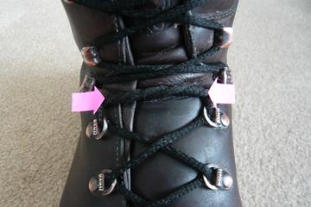
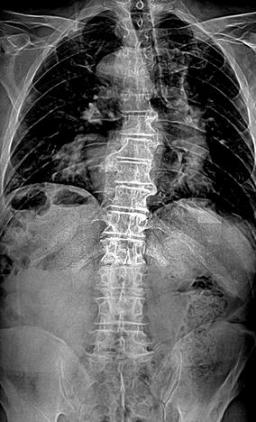


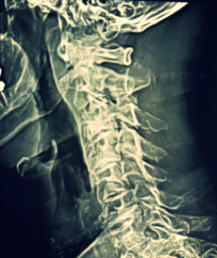
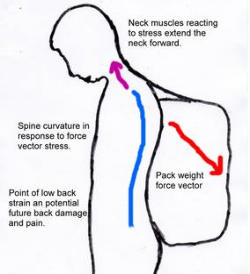
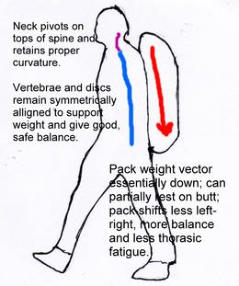


Save your back - come prepared to drag out your
game - especially in deep snow when unsure
footing could result in a stumble, fall or wrenched back.
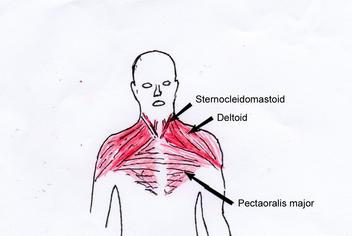

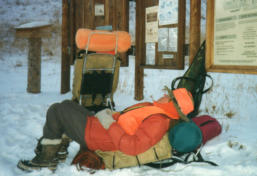




- Hunter welfare
- Hunter poster child
- Altitude sickness
- Hunter heart attacks
- Hunter heart stress
- Altitude sleep problems
- Hunter spine/bone damage
- Back country hazards
- Man made hazards
- Hunter bear attacks
- Bear problems
- Mtn lion Awareness
- Insect problems and diseases
- Hunt camp rodent problems
- Game meat dangers
- Elk meat diseases


Hunter Neck, Spine,
Bone and Foot Risks
Hunter Back Injuries: You do not see many hunting
articles about simple back and leg hazards. Hauling
large packs in and meat loads out takes its toll. Do it
right or pay the consequences later in life. I made it,
but the toll was the loss of three inches in height and
the absence of most functional vertebral discs. I have
no intent lecturing about lifting weights and
backpacking heavy loads. Do let me tell you that
during wet, icy, and snowy weather you have to
adjust to conditions. Pushing your weight-carrying
limits on a mucky trail may result in breaking a leg or
wrenching your back. Five miles from a road head is a
walking eternity if your back or neck is dislocated.
Slowly driving a potholed road to medical help is
going to be the final painful blow.
I have driven back-injured men and heard them
whimper at the road ruts. I recall the year I took Josh
elk hunting with me. Josh had driven nonstop nearly
1,500 miles. He was tired when he got to my house
(late and exhausted), and the four hour ride to elk
base camp did not adequately replenish sleep. We
were setting up a temporary base camp when Josh
somehow dislocated his back. After three hours, he
relented and let me drive him back to Denver for
medical treatment. The forty-mile drive to the
interstate drew tears to Josh’s eyes, especially when
my Suburban bumper sideswiped a large boulder
hidden in the deep snow. He got chiropractic and
medical treatment, and a day of rest. We were two
days late for opening day, but like all enthusiastic elk
hunters, he fought for and got a nice bull. {Interest
note: I had a sedentary job that resulted in chronic
back problems. My back ALWAYS recovered before
hunting seasons because I exercised more.}
I now carry a week’s supply of back muscle relaxant
medicine and prescription pain medicine when
backpacking or hunting. At every yearly physical, I
give the doctor the remaining medicine for disposal
(commonly all is left) in return for prescriptions for
fresh medicines. I started this relationship when I
picked up a fish in a remote lake I built along the
Continental Divide. Linda wire-sawed avalanched
trees with bent bases to fit my hips top contours.
Then she strapped me tightly into this back brace and
we walked the seven miles up to the Continental
Divide and out to I-70, where highway crew members
helped lift me into our Blazer.
Protect Your Knees: Many backpacking and hunting
articles reviewing potential physical and
environmental danger fail to point out a quite likely
obvious hazard – a knee injury. A simple stumble
while boulder bashing a trail can bring a painful and
potentially life-long knee condition. Of all the places
on your body not to fall, the knee is the worst and
most often unforeseen accident. A moderate strike
below the kneecap might initially only slightly hurt,
but the bruise may progress to ligament damage and
water boils under the kneecap. I remember slightly
tapping my knee. It swelled to double size by the next
day, and then my entire leg turned black and blue. Be
tender to your precious knees. Walk slower to
maintain good balance. Off-load some things and
make a second trip when hauling heavy loads (think
game meat) downhill. Getting in the in the
predicament of being forced down on your knees can
be devastating to the hunt.
Treasure and Protect Your Joints Treasure and
respect your vertebrae! Do not overload or over tax
them. Lift properly to preserve them. Never lift with a
twist, as when jerking a heavy, clumsy backpack up to
your shoulders. Outdoor activities demand you stay
comfortably ambulatory well into old age.
How do hummingbird wings do that! Birdwatchers
recently began banding humming birds in Florida.
Banding the tiny birds had never been done before
because they are difficult to catch (and later recatch)
without injuring them. Their miniscule legs allowed
only thin, fragile bands with little information. Beside,
few people cared where they went, supposing that
they “went to the mountains for the summer” before
returning the following fall. Not so! The rascals
banded in Tallahassee, Florida were caught
summering in Anchorage, Alaska! Those puny little
birds flew over 3,500 miles over the Rocky Mountain
for their summer vacation, and then flew back! Plus,
they fluttered about at winter and summer feeding
locations. That is one heck of a feat running on flower
nectar!
Let’s look at how much hummingbird wings are used.
They flutter at 50-70 times a second 60 flutters X
60secopnds X60mionutes X24hours X365days =
1,892,160,000 wing beats a year. How do they do that!
I am dead serious: some graduate student should
study the hummingbird wing joints to develop a
legitimate human joint supplement. That should
bring her/him billions. It might also result in a life-
extending elixir – who knows, what helps joints might
help the heart! (Note: the black billed warbler
songbird is only slightly larger than a hummingbird. It
migrates over the Pacific Ocean from New Zealand to
Alaska and to Japan and back. Do not underestimate
nature. Learn from it.
Pay for a Good, Perfectly Fitted Boots – Or Suffer
Later: Invest in a good pair of boots for comfort and
foot preservation. Make sure they are correctly fitted.
They should have strong, thick Vibram soles, and
have strong built-in arch support to prevent foot
failure and permanent flat feet. A poor or absent arch
support will also shift more body weight to the heel
bottom, resulting in gradual growth of an exceedingly
painful basal bone spur that may take years to get rid
of. Boots should extend over and be supportive of the
ankle to reduce sprains
Custom Boots Fitted by Experts are Worth the
Cost: People buy boots today by mail order or from a
local sports store which has inexperienced
salespersons. Most will never experience the
wonders of perfectly fitted boots, and some will
suffer future foot and ankle problems.
We relocated to Denver in 1969. New backpacking
friends vehemently declared we should get the best
boots plus free advice from Hans the German, an
eighty year old (and still playing soccer) legendary
boot maker on East Colfax Avenue. He was an
extremely rare find from the “old school”. If you were
coming to him, you were going to receive boots that
were appropriate to HIS liking. The first thing he did
was to yell at his wife to prepare another customer
(he was always politely but loudly yelling commands
to his wife.) Linda was properly seated in a fitting
chair barefooted with her old boots neatly beside her.
Hans intermittently eyed her as he went about
business with other customers. Hans carefully looked
at Linda’s feet and then her old boots. “How bad is
the pain in the left side of your neck?” he asked
(actually, a tort German command). Linda had this
neck pain for years and Hans instantly detected it. He
knew the adage “Look at a man’s shoes and you know
how he lives”.
Linda got a perfect pair of boots for her narrow feet.
Hans made and glued a wedge-shaped leather
“cookie” at a certain place inside her boot. In a week
or two, her neck pain disappeared and never
returned!
Hans refused to sell me the impressive stylish hiking
boots I selected, demanding I buy a more farmer-
looking rugged type for my “German-Italian fat feet!”.
I used those relaxing boots that felt like slippers
through five resolings. (Note: Peter Limmer and Sons
in New Hampshire make custom boots for hard to fit
feet. It may take up to three years for the boots to be
made. However, they will order contract-made
specialty-to-fit boots made in the former East
Germany with arrival time in weeks.) .
Buy Quality Boot Laces for Comfort and Safety -
Good Boot Laces Are Almost Worth Their Weight
in Gold!The backcountry is not the place to wear
poor grade bootlaces.There are many cheap ones on
the market that stretch, break of loose their end caps.
They fray, absorb water and freeze, and creep
through boot eyelets. Obtain some Obenauf’s
Industrial Strength Boot Laces. These quality laces are
impregnated with a beeswax/resin/oil mixture. This
reduces abrasion, fraying, mildew, heat and chemical
damage and water saturation. Water proofed laces
do not ice up and become difficult to untie. The
waterproofing composition also reduces or
eliminates the creeping of laces through eyelets, and
thus keeps your laces tight around the foot.
Properly Tie Your Boot
Laces for Maximum
Comfort and Foot Safety:
Boot maker Hans had a big
granite rock in his boot
store’s tiny fitting room. You
climbed on and around that
rock to his commands as he observed the boots
flexing and the ankles moving. Then he would teach
like a child you learn how to correctly lace a boot for
backpacking. This photo illustrates the proper way to
tie a boot so the foot and ankle are not injured or
fatigued, or a good boot ruined. The lace is pulled
increasingly tighter each eyelet at a time until the
break in the ankle is reached. Then the laces are
wrapped around each other several times BELOW the
lowest point of boot flexure (arrows). This
intertwining prevents the foot’s flexing action from
pulling and stretching the upper lacers downward to
loosen the lower laces. The boot front retains firm
lacing, thus preventing the foot from moving forward,
and foot tarsal bones from spreading. You will
experience less foot fatigue, toes hitting the boot
front, and better walking balance. The foot will not
slip forward in the boot when walking downhill; this is
a dangerous time when carrying a heavy load of
meat. The boot will be able to bend better at the
ankle break point, and this will prevent blistering of
the tender ankle front. Note: Never use lacers which
stretch at all. They allow foot slippage resulting in
blisters.
Pre-Season Back Exercise to Increase Your High
Altitude Breathing: You have two diaphragms
melded as one. There are two phrenic nerves
coursing down from your neck vertebrae to control
these two diaphragm sections, which usually act in
unison. Three quarters of your air inspiration results
from your diaphragm pulling down from your neck
vertebrae to control these two diaphragm sections,
which usually act in unison. Three quarters of your air
inspiration results from your diaphragm pulling down
toward the body cavity. The diaphragm will have to
work harder if it has to push down against an
enlarged abdomen (think big gut). Try to get rid of
that gut. Think of hunting all year, not beer.
About one-quarter of inspiration occurs through the
muscular action of your rib cage. Intercostal muscles
contract to make the lung cavity smaller by pulling the
ribs together and inward, thus more completely
expelling carbon dioxide enriched air. If you are not
physically adjusted to rarified air, you may experience
rib muscle fatigue and pain until the intercostal
muscles become toned. Consider beginning to tone
the intercostal muscles and your back muscles with
deep breathing well before the season. You will be
able to sleep better if your chest rib muscles are not
tender and do not ache at night.
Breathing Exercises for your Health and
Awareness: Doctors advise breathing and breath
control is the easiest way to improve your physical
and mental health. Train yourself to breathe deeply
and slowly to boost your immune systems and heart
health. Begin breath training well before the hunting
season and you will adjust to high altitudes easier
and quicker.
Many of us are tied to the computer during the
workday and at home. Your computer work may
indirectly create stress, headaches and fatigue – but
not just in the ways you might suspect. “Fitbit”
exercise tracking devises monitor your physical
activity. “Spire” is a wearable device that monitors
your breathing rhythm, types, and efficiencies. It was
used to expose a new kind of apnea, which is a
temporary cessation of daytime breathing. People in
a computer work study often held their breath, and
they commonly took short, shallow breaths that were
insufficient to optimally exchange carbon dioxide for
oxygen. This results in fatigue, sleepiness and
physiological stresses on body organs like the heart.
There are two types of breathing. Most people
breathe “vertically” using mainly their chest,
shoulders and neck. When exhausted or excited they
use the diaphragm more. A better method of
breathing is to use your diaphragm to do most of the
inhaling and expiration of the lungs. This breathing
type is taught in stress-relief Yoga classes. It involves
inhaling rather quickly by pulling your diaphragm
down into your gut. Then slowly, deeply exhaling
completely. The diaphragm flattens and the ribs flare
out. Throughout the year, maintain good posture
when working at the computer. Sit straight, do not
lean forward on your gut, or slouch to the side when
on the telephone.
Muscle Tone Your Neck
Before Hunting: There
are three basic
movements of the neck:
extention, flexation, and
lateral rotation. There are
some exercises you can do
to get in shape for the
additional stresses placed
on your neck by carrying backpacks and even the
heaver loads of winter clothing, gun and ammunition.
Extention: place your two hands cupped behind your
neck. Gradually pull the hands forward as you push
the neck backward. The chin should never be pulled
down from further that being level with the floor.
Hold that strained position several seconds and then
repeat the exercise several times. Alternate with the
other two exercises. NOTE: Never pull your hands
downward because this can cause damage to the
cervical discs and alignment.
Flexation: Make fists of your hands and place them
together under your chin. Try to push upward while
straining the neck to pull down. Hold the position 3-5
seconds and repeat.
Lateral: Place one hand over the top of your head and
try to pull it sideways as you try to resist the
movement with the neck muscles. Hold several
seconds and repeat several times. Do not twist the
neck while doing this because cervicals may be
damaged.
Tone Your Shoulder Muscles: The hunting season
transition to using your shoulders more for packing,
slinging a gun or reaching higher than normal to
move branches results in tired shoulder muscles.
Tone muscles with shoulder shrugs as you walk, jog
or watch TV. Over days gradually increase the weight
by using a water filled gallon milk jug in each hand.
Carry and toss a rounded cobble from hand to hand
as you hike. Graduate into backpack training with
ever-increasing loads of water filled milk bottles.
Tone Your Diaphragm: Effective
deep breathing without pain at high
altitudes will occur if you tone the
muscles in your diaphragm. This
exercise uses the weight of your gut
to make your diaphragm work
harder. It will also make the muscles
between our ribs work harder and
tone. Kneel on your knees with your
hands flat on the floor and keep your
back straight. Slowly take very deep
breaths and equally slowly exhale
completely. Do this over many days
until the discomfort disappears.
Strengthen Your Diaphragm and
Respiratory Muscles:
This exercise uses your abdomen as a resistive
weight against chest and diaphragm muscles. Begin
by sitting straight-backed in a chair and slowly
breathing very deeply in and pushing completely out
your gut on the exhale. Do the numerous times and
gradually increase the holding periods. Progress to a
second exercise after a few days. Kneel on the floor
with your place hands flat on the floor. Do the inhale-
exhale exercise above. This will be harder, because
the weight of your hanging gut presents more
resistance to inhaling.
Correct and Preserve Your Back
Posture: Realign the back muscles if
your lifestyle and job have created
muscular asymmetry. In this age,
more people are becoming sedentary
on the job and at home. Physical
exertion is limited. Desk jobs can lead
to poor posture. Leaning sideways
against a desk while on the phone,
driving long distances slouched
against the door, carrying a heavy
handbag or briefcase in the same
hand and a host of other activities
can lead to spinal muscular asymmetry, which
gradually results in spinal curvature. A straight,
muscularly balanced, strong back is less likely to incur
sprains and damage. In addition, you can breathe
easier and better. Carrying even a light backpack can
“lift up” the shoulders and strengthen the back
muscles. The mere reoccurring act of trying to keep
both pack straps on your shoulders gradually tones
the back muscles. Slowly adding more weight such as
another bottle of water continues the toning. Try
raising your shoulders and simultaneously deeply
breathe while you read this. Notice that you can
inspire more air and quicker when your shoulders are
not drooped? Toning your intercostal muscles will aid
you when later ambulating at high altitudes,
particularly when you tote a heavy pack of gear or
meat.
Preseason Tone Shoulder and Neck Muscles: The
drawings below indicte the muscles which should be
strengthened before elk season. Begin by carrying a
lightly-weighted backpack on hikes and gradually add
weight. Use water filled milk bottles and increase the
amount of water on successive outings. I have read
articles suggesting emptying the bottles before
descending trails. This is not advisable, because
weight carried downhill will help tone the shin
muscles that can be devastated when trudging down
steep grades with a heavy load of meat.
Backpacks
Can
Damage
Your
Spine
and
Neck:
Using
an
improper
backpack
or
stowing
items
in
it
can
put
excessive
strain
on
the
neck
vertebrae.
Long-
t
erm
bone
and
muscle
damage
can
result
as
the
spinal
and
cervical
vertebrae
realign
to
compensate
for the continued stresses.
The
x-ray
image
on
the
left
is
of
a
neck
with
normal
forward
curvature.
The
curvature
allows
the
neck
bones
and
discs
to
absorb
some
shock
when
walking,
and
lets
the
head
rotate
on
the
vertebrae.
The
image
on
the
right
is
of
a
neck
that,,
through
years
of
stress,
has
realigned
to
what
is
called
“Foreward
Leaning
Neck”.
It
is
also
in
dislocation
[cervical
subluxation,
C3
retrolisthesis].
Note
the
third
vertebra
down
is
cocked/slipped
to
the
right.
This
pinches
the
enclosed
spinal
cord.
The
inflammation
affects
nerves
emerging
from
the
vertebrae.
The
neck
is
straight
and
inflexible.
The
bone
protrusions
on
the
back
of
the
cervical
vertebrae
are
splayed
and
do
not
nestle
correctly.
These
protrusions
can
rub
together
causing
nerve
and
muscular
inflammation,
resulting
in
debilitating
muscular
spasms
similar
to
leg
muscle
cramps
–
but
much
more
painfully
and
potentially
more
dangerous.
It
is
not
a
nice
condition
and
it
can
result in permanent damage!
Misaligned
bones
deform
and
undergo
"remodeling"
changes
that
become
permanent.
Using
an
improper
backpack
or
stowing
items
in
it
can
put
excessive
strain
on
the
neck
vertebrae.
Long-term
bone
and
muscle
damage
can
result
as
the
spinal
and
cervical
vertebrae
realign
to
compensate
for
the
continued
stresses.
On
the
left
diagram
(below),
the
force
vector
is
essentially
straight
down.
This
allows
the
spine
to
remain
straight
AND
the
head
to
remain
vertical
upon
the
neck.
The
correct
backpack
is
a
deep
pack.
The
weight
vortex
is
pulling
down
away
from
the
body,
causing
the
shoulders
and
head
to
lean
forward.
The
spine
is
curved,
resulting
in
the
intervertebral
discs
to
distorting
under
long-term
pressure.
High
backward
force
is
exerted
on
the
neck,
causing
it
to
straighten
to
carry
the
backward-pulling
weight
force.
Extensive
backpacking
under
these
stresses
is
asking
for not only back damage, but also neck problems.
Use
a
Proper
Backpack
to
Avoid
Spine,
Hip
and
Knee
and
Foot
Damage:
An
eighty-pound
bull
elk
hindquarter
is
a
beast
to
pack
far.
It
can
really
tear
up
your
body
and
resolve
to
pack
out
the
rest
of
the
meat,
especially
the
same
day.
I
strongly
recommend
hunters
use
a
dedicated
backpack
for
hauling
heavy
meat
loads
out
of
the
backcountry.
The
pack
should
allow
loads
to
be
strapped
close
to
the
back.
Few
soft
packs
allow
this,
since
cinching
up
the
bag
does
not
result
in
forcing
the
weight
forward
flat
against
your
back,
but
into
a
barrel-shaped
drooping
lump.
A
hard
frame
pack
(or
even
old
pack
board
frame)
permits
straps
and
rope
to
bring
weight
close
against
the
back.
This
reduces
backward
pull,
tiring
pack
swaying,
load
shi
fting,
and
thumping
against
an
unprotected
lower back.
The
pictured
Himalayan
brand
pack
frame
weighs
less
than
eight
ounces
(total),
has
lugs
for
cinching
meat
bags
to
the
frame,
a
webbed
back
rest
for
ventilation
and
comfort,
and
a
hip
belt
to
reduce
strain
on
the
back.
It
stores
easily
in
a
vehicle
and
is
a
potential
“trade”
item
to
hunters
who
came
less
prepared.
It
cost
half
a
dollar
at
a
garage
sale.
Fill
your
backpack
with
the
heaviest
items
forward
and
placed
high,
against
the
upper
back.
Put
the
lightest
objects
on
the
bottom
and
against
the
rear.
Pay
attention
to
balance
left-right
weight
distribution
when
packing
to
reduce
pack
swaying
that
will
tire
shoulders.
Then
cinch
the
pack
tightly
to
prevent
load
shifting.
Change
Body
Load
Positions
During
the
Year:
Avoid
carrying
loads
such
as
a
pocketbook,
daypack,
book
bag
or
even
the
dog
leash
over
the
same
shoulder
or
arm.
Your
body
continually
responds
to
forces
exerted
on
it.
Using
one
shoulder
to
carry
weight
creates
lateral
asymmetry
of
muscles.
This
can
result
in
gradual
misalignment
of
the
spinal
column,
uneven
muscular
development
and
rising
of
the
more-used
shoulder.
Lateral
stress
will
be
exerted
on
the
spine,
which
gradually
deforms
in
response
to
the
asymmetrical
load.
It
takes
a
while
to
create
spinal
damage,
but
it
will
take
a
heck
of
a
lot
longer
to
correct
it!
Alternate
hands
carrying
a
rifle
and
avoid
carrying a rifle over a preferred shoulder.
Y
ear-Round
Treasure
and
respect
your
vertebrae!
Do
not
overload
or
over
tax
them.
Lift
properly
to
preserve
them.
Never
lift
with
a
twist,
as
when
jerking
a
heavy,
clumsy
backpack
up
to
your
shoulders.
Love
of
outdoor
activities
demands
you
stay
comfortably
ambulatory well into a golden old age.
Prevent
Child
School
Backpack
Spine
Injuries:
S
coliosis
(bent,
misaligned
spinal
column)
affects
a
considerable
number
of
children.
Besides
congenital
spine
abnormalities
developed
in
the
fetal
stage.
Growing
evidence
suggests
birthing
itself
may
cause
initial
spine
damage.
Poor
early
childhood
posture
of
the
hip
and
head
cause
the
developing
child's
spine
to
grow
out
of
alignment.
While
boys
develop
scoliosis,
girls
between
the
ages
of
8
to
18
seem
most
prone.
Perhaps
one
reason
social
peer
pressure
to
take
popular
posture
as
they
reach
puberty
and
want
to "look cool" and differently attractive.
Physicians
recognize
school
backpacks
are
a
source
of
spinal
misalignment
during
the
critical
early
years
of
bone
development.
Some
children
have
poorly
fitted
(oversized,
poor
strap
support,
too
deep,
too
thick,
and
swaying)
school
backpacks
in
which
they
carry
up
to
30-40
pounds
of
books
and
gear.
That
is
a
tremendous
strain
on
young,
still
forming
bones
and
muscles.
This
forces
the
head
forward
to
counterbalance
the
weight
with
stress
to
the
joints,
discs
and
nerves
of
the
neck.
This
load
is
especially
damaging
if
the
child
sling-carries
the
pack
over
one
(usually favored) shoulder.
Doctors
recommend
a
child
carry
no
more
than
15%
of
their
weight,
and
that
they
always
carry
it
with
BOTH
straps
equally
loaded
and
properly
adjusted.
Consider
getting
a
collapsible
airport
luggage
dolly
for
the
child
to
use
on
days
when
there
is
a
heavy
load.
(Note:
Have
your
child
medically
tested
for
scoliosis
immediately
if
you
notice
spine
curvature,
shoulders
not
at
equal
levels
when
standing,
or
if
the
child
seems
to
favor
poor
posture
for
comfort.
Untreated
scoliosis
can
lead
to
serious
consequences,
including
spinal
rod
implant
surgery,
maybe
multiple
surgeries.
Like
everything
else
in
life,
it
is
easier
and
cheaper
to
prevent a problem than to fix it.
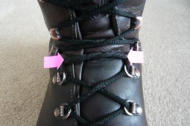



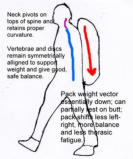


© 2016 -2021 Copyright by P. K. H. Groth, Denver, Colorado, USA All rights reserved -
See contact page for for permission to republish article excerpts.


- Hunter welfare
- Hunter poster child
- Altitude sicknesses
- Hunter heart attack
- Hunter heart stress
- Altitude sleep problems
- Hunter spine and bone injuries
- Back country hazards
- Man caused hazards
- Bear attacks
- Bear camp problems
- Mountain. lion awareness
- Insect diseases and problems
- Camp rodent problems
- Game meat dangers
- Elk diseases

























